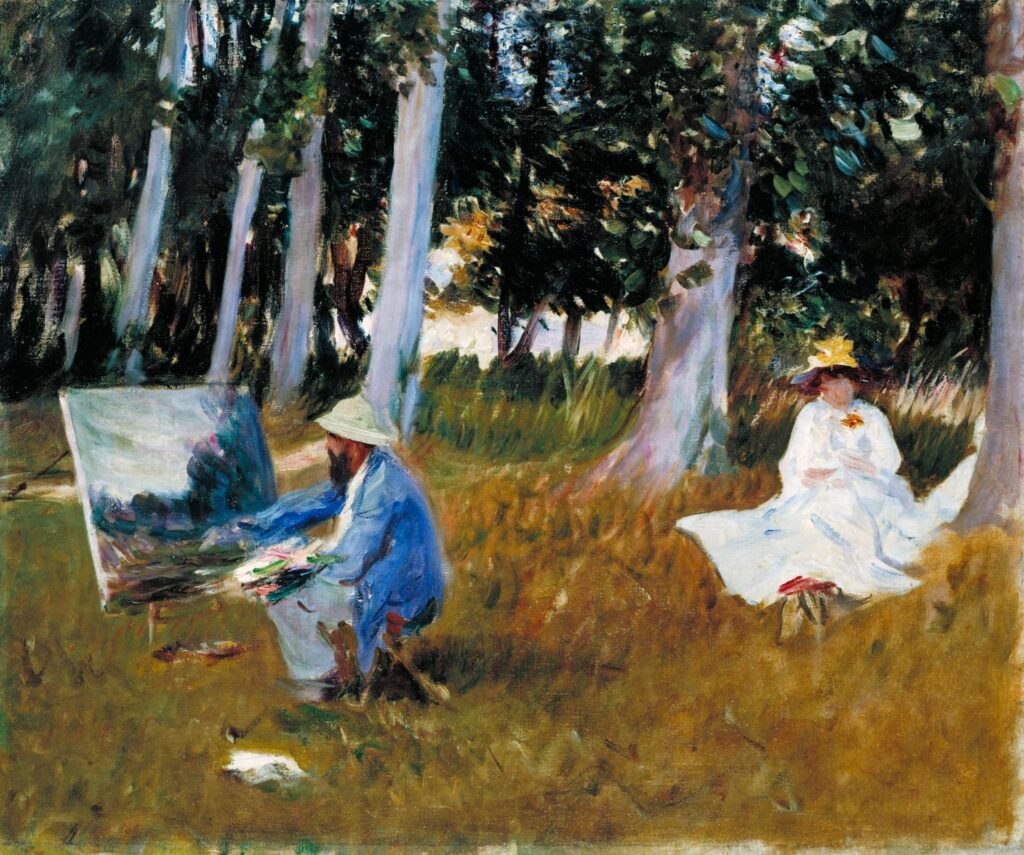A to Z of Landscapes: Oil sketch

Although landscapes can be and have been painted in almost any medium, perhaps the most important have been sketches made in oil paint in front of the motif. Thus, in this alphabet of landscapes, the letter o stands for those oil sketches.
Albrecht Dürer (1471–1528), View of Innsbruck (c 1495), watercolour on paper, 12.7 x 18.7 cm, Albertina, Vienna, Austria. WikiArt.
While watercolours have long been convenient and popular, seen here in Albrecht Dürer’s View of Innsbruck from about 1495, it was probably well over a century before the first oil sketches appeared.
Diego Velázquez (1599–1660), Villa Medici in Rome, Pavilion of Ariadne (1630) [43], oil on canvas, 44.5 x 38.5 cm, Museo Nacional del Prado, Madrid, Spain. Wikimedia Commons.Diego Velázquez’s pioneering paintings made in front of the motif when he was in Rome in 1630 show a new challenge to landscape painting. If an artist is going to depict what they see in front of them, and paint that outdoors, en plein air, how can they make oil sketches?
Alexandre-François Desportes (1661-1743), Landscape Study (c 1700), oil, dimensions not known, Palais des beaux-arts de Lille, Lille, France. Wikimedia Commons.
Although there are claims that later in that decade others followed suit, the next surviving plein air oil sketches are those of Alexandre-François Desportes (1661-1743). He was a professional painter of hunting scenes and animals, and is reported to have made some oil sketches in front of landscape motifs.
Plein air oil sketching was described, and recommended, by Roger de Piles in his book Cours de Peinture, published in 1708, contemporary with Desportes’ sketches. Other books on painting and art in the eighteenth century also cover the topic, and Claude-Joseph Vernet was recorded as having painted oil sketches en plein air, but none has survived.
Pierre-Henri de Valenciennes (1750–1819), Farm Buildings at the Villa Farnese: the Two Poplar Trees (1780), oil on paper on cardbord, 25 x 38 cm, Musée du Louvre, Paris. Wikimedia Commons.
At Vernet’s suggestion, the young Pierre-Henri de Valenciennes made copious oil sketches such as this of Farm-buildings at the Villa Farnese: the Two Poplar Trees when he was painting in the Roman Campagna in 1782-85. He not only built himself a large visual library of sketches from nature, but published a widely-used book on landscape painting in which he recommended the practice.
Pierre-Henri de Valenciennes (1750–1819), View of Rome (date not known), oil, 19.5 x 39 cm, Cleveland Museum of Art, Cleveland, OH. Wikimedia Commons.
Valenciennes painted this magnificent View of Rome in front of the motif during that period. Notable here is the depiction of the clouds of dust and smoke rising from the streets of the city, which surely qualify it as an ‘impression’.
Thomas Jones (1742-1803), A Wall in Naples (c 1782), oil on paper laid on canvas, 11.4 x 16 cm, National Gallery, London. Wikimedia Commons.
At roughly the same time, the father of Welsh landscape painting, Thomas Jones, was in Rome doing exactly the same. This tiny work of his in London’s National Gallery is a gem worth seeking out.
John Constable (1776–1837), A View at Hampstead with Stormy Weather (c 1830), oil on paper on panel, 15.6 x 19.4 cm, Yale Center for British Art, New Haven, CT. Wikimedia Commons.
I can’t find any evidence that John Constable was influenced by either Valenciennes or Jones, but he too used oil sketches made in front of the motif to develop his large finished works. From about 1810 onwards, these included many cloud studies in what he called ‘skying’.
Jean-Baptiste-Camille Corot (1796-1875), View of the Convent of S. Onofrio on the Janiculum, Rome (1826), oil on paper mounted on canvas, 22 x 33 cm, Fitzwilliam Museum, Cambridge, England. WikiArt.
The first major landscape painter to adopt Valenciennes’ practice and to show his sketches in public was Camille Corot. During his first stay in Italy, between 1825-28, he developed his skills painting outdoors in the Campagna, producing classics such as those above and below.
Jean-Baptiste-Camille Corot (1796-1875), The Bridge at Narni (1826), oil on paper, 34 x 48 cm, Musée du Louvre, Paris. WikiArt.
Carl Eduard Ferdinand Blechen (1798-1840), Tiberiusfelsen auf Capri (Tiberius Rocks, Capri) (1828-9), oil on paper mounted on canvas, 20.5 x 30 cm, Lower Saxony State Museum, Hanover. Wikimedia Commons.
By this time, Valenciennes’ teaching had spread across Europe, and all good landscape painters in training aimed to spend at least a couple of years learning to paint en plein air in the countryside around Rome. Shown above is a fine example of the island of Capri, off the coast of Naples, painted by the German artist Carl Blechen.
Eugène Boudin (1824–1898), Pardon of Sainte-Anne-La-Palud (study) (1858), oil on wood panel, 23.2 x 17.5 cm, Musée d’art moderne André Malraux, Le Havre, France. Wikimedia Commons.
Plein air painting in northern Europe was slower to get off the ground, because of the more fickle and inclement weather. Corot continued to paint outdoors when he was back in France, and in the middle of the nineteenth century Eugène Boudin popularised oil sketches on the northern French coast.
On the last weekend in August, 1857, Boudin visited the Finistère region’s largest religious celebration, and made sketches in oils, including The Pardon of Sainte-Anne-La-Palud (study) (1858). These he used to paint a more traditionally finished oil painting, exactly as taught by Valenciennes, which was shown in the Paris Salon the following year, where it was praised by Baudelaire.
Johan Barthold Jongkind (1819-1891), Environs of Breda (1857), oil on canvas, 30.3 x 45.6 cm, Museum of Fine Art, Houston. Wikimedia Commons.
Another important plein air landscape painter of the time was Johan Barthold Jongkind, whose work has sadly been more neglected.
Boudin was a major influence on Claude Monet, and Corot on Camille Pissarro, two of the most important of the Impressionist landscape artists.
Camille Pissarro (1830-1903), View of Alleyn Park, West Dulwich (c 1871), oil on canvas, 43.5 x 53.5 cm, Kimbell Art Museum, Fort Worth, TX. Wikimedia Commons.
Pissarro was taught by Camille Corot, and became one of the most skilful and adept plein air artists ever. In order to capture as much of the ‘truth of nature’, he frequently achieved great detail in his paintings by working on them over periods of several days. This enabled him to depict complex and densely populated views, such as those he painted during his period of Divisionist style, and the human panoramas of his late career.
John Singer Sargent (1856–1925), Claude Monet Painting by the Edge of a Wood (c 1885), oil on canvas, 54 x 64.8 cm, The Tate Gallery (Presented by Miss Emily Sargent and Mrs Ormond through the Art Fund 1925), London. © The Tate Gallery and Photographic Rights © Tate (2017), CC-BY-NC-ND 3.0 (Unported), http://www.tate.org.uk/art/artworks/sargent-claude-monet-painting-by-the-edge-of-a-wood-n04103
Claude Monet also took plein air painting in new directions, although in many ways his works confuse the whole practice. John Singer Sargent first met Monet in 1876, and in about 1885 they painted together en plein air in the grounds of Monet’s house in Giverny, a good opportunity for one superb exponent of plein air painting to paint another.




